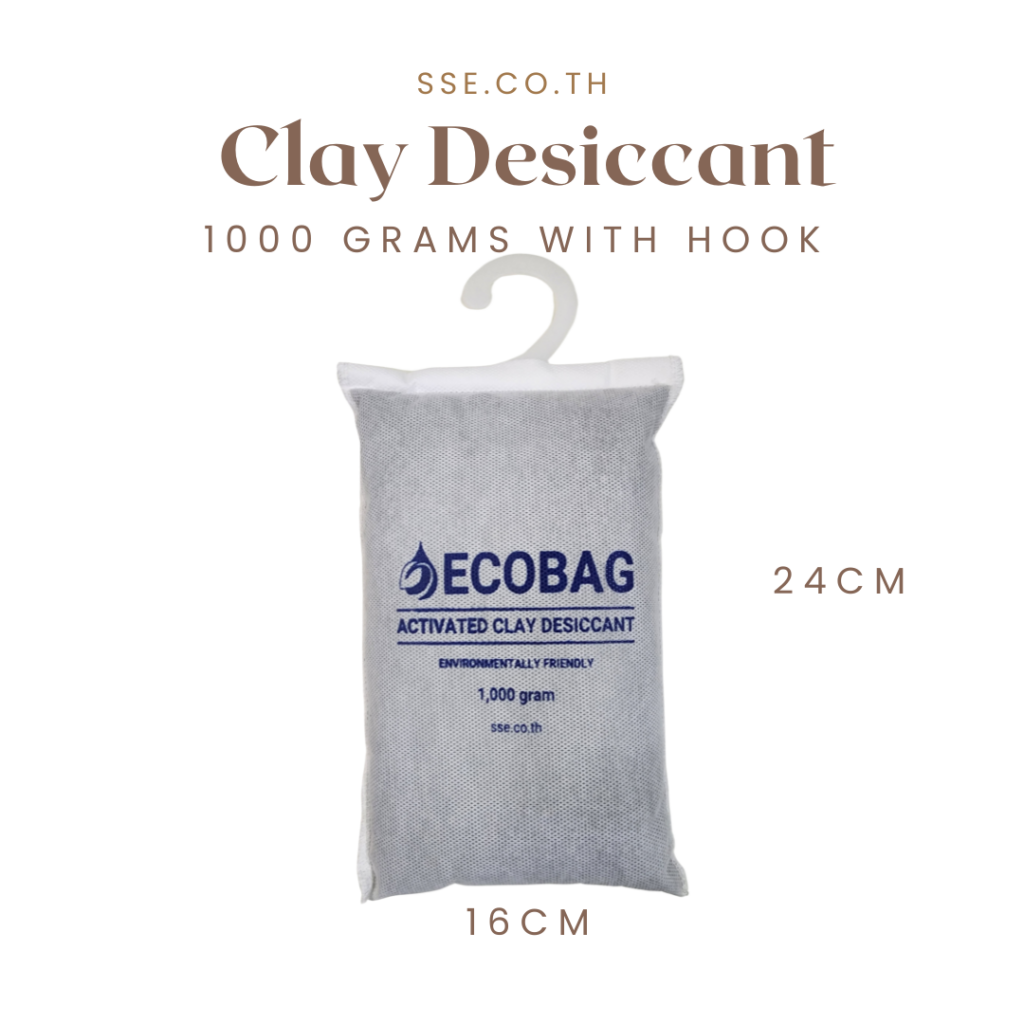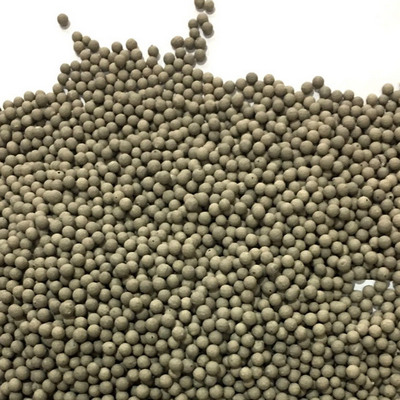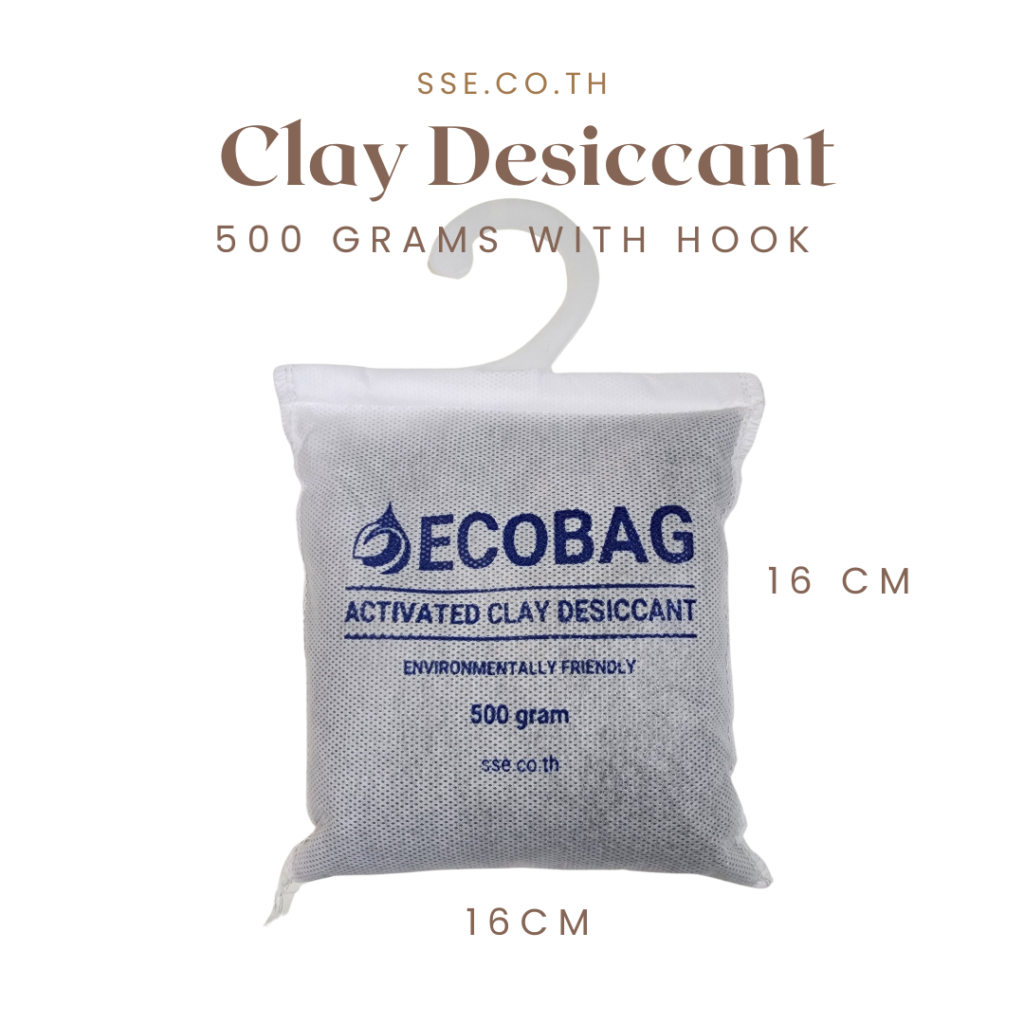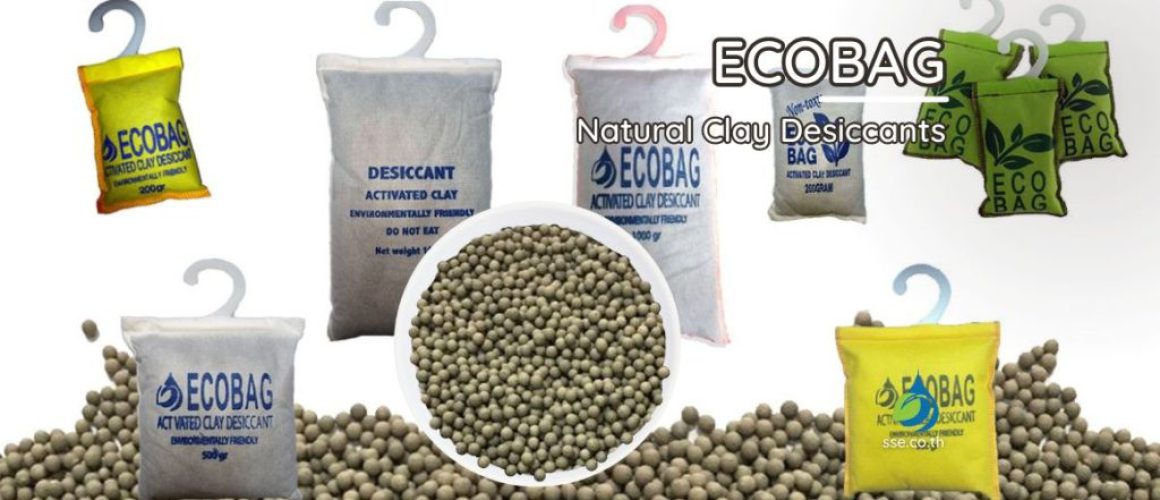Ecobag Natural Clay Desiccant 2024
| Topic | Key Takeaway |
|---|---|
| Eco-friendliness | Activated clay is natural, non-toxic, and biodegradable, making it an environmentally friendly choice. |
| Absorption Capacity | It can absorb more than 50% of its own weight, offering excellent moisture protection for long periods. |
| Applications | Used in multiple industries, including food, pharmaceuticals, and electronics for moisture protection. |
| Advantages over Alternatives | More cost-effective and safer compared to silica gel and other synthetic desiccants. |
| Product Options | Available in different sizes to cater to varied customer needs. |
Table of Contents
Introduction
Activated clay desiccant, branded as Ecobag, is a natural and sustainable solution for moisture control across industries. Made from highly absorbent natural clay blended with calcium chloride, this desiccant is effective, eco-friendly, and cost-efficient. Unlike synthetic alternatives, activated clay is non-toxic, biodegradable, and provides long-lasting moisture protection without altering its physical state. Whether you are shipping sensitive goods or protecting storage environments, Ecobag Activated Clay is designed to deliver reliable, environmentally-conscious moisture control for your products.
Ecobag Natural Clay Desiccant: An Eco-Friendly Alternative
Activated Clay is a natural substance with the remarkable ability to absorb moisture from the environment. It is an excellent choice for those seeking an eco-friendly and safe way to control humidity in various spaces. This desiccant is made from natural ingredients, primarily clay blended with calcium chloride, making it cost-effective, chemical-free, and reusable. Its environmentally friendly nature makes it ideal for moisture control without harming the surroundings. See also: สารดูดความชื้นที่ทำจากดิน: ทางเลือกที่เป็นมิตรกับสิ่งแวดล้อม
What is Activated Clay?
Activated Clay is a type of desiccant made from natural clay minerals with excellent moisture absorption properties. It is a blend of key components, including Attapulgite, Bentonite, and Calcium Chloride, each contributing distinct benefits:
- Attapulgite: A highly absorbent clay mineral that forms the foundation of activated clay desiccant. It has a large surface area and a unique crystal structure that enhances its moisture absorption capabilities.
- Bentonite: This clay enhances the overall adsorption properties, allowing the desiccant to capture a variety of contaminants beyond moisture, such as odors.
- Calcium Chloride: A hygroscopic compound that significantly boosts the moisture absorption rate of the desiccant, ensuring efficient performance even in high-humidity environments.
Activated Clay’s natural composition makes it eco-friendly and non-toxic, providing an effective solution for controlling humidity without compromising the environment.

Why Choose Activated Clay Over Other Desiccants?
Activated clay offers several advantages over other types of desiccants, such as silica gel and molecular sieves:
- Cost-Effectiveness: Activated clay is generally more affordable compared to silica gel and molecular sieves, making it an economical choice for moisture control across various applications. Its natural components keep production costs low, which benefits customers seeking budget-friendly solutions.
- Eco-Friendly Attributes: Unlike synthetic desiccants, activated clay is made from natural, non-toxic, and biodegradable materials. It does not pose environmental hazards and can be disposed of easily without harming ecosystems, unlike certain chemical-based desiccants.
- Absorption Efficiency: While silica gel and molecular sieves are known for their high moisture absorption, activated clay competes effectively by absorbing up to 50% of its weight in moisture. The addition of calcium chloride boosts its absorption rate even further, making it highly suitable for environments with fluctuating humidity levels.
- Reusable and Sustainable: Unlike molecular sieves that can be challenging to regenerate, activated clay can be reused after drying, making it a sustainable option for long-term moisture management. This reusability adds to its cost-effectiveness.
- Safety: Activated clay is non-toxic and safe to handle, whereas some desiccants, such as molecular sieves, require careful handling due to their chemical properties. This safety factor makes activated clay ideal for a wide range of industries, including food, pharmaceuticals, and consumer goods.
Overall, activated clay stands out as a cost-effective, eco-friendly, and efficient moisture control solution, suitable for industries looking for reliable desiccant options without compromising environmental responsibility.
Features and Benefits
- Eco-Friendly: Activated Clay is a natural, non-toxic, and biodegradable desiccant, ensuring minimal environmental impact while providing effective moisture control.
- High Absorption Capacity: It can absorb more than 50% of its own weight in moisture, making it a reliable option for controlling humidity in various settings.
- Durability: Even at full saturation, activated clay remains stable and does not leak, ensuring that it keeps the surrounding environment safe and protected from excess moisture.

Applications of Natural Clay
Activated Clay Desiccant has diverse applications across various industries and settings:
- Industrial Use: Activated clay is widely used in industries such as electronics, automotive, food, and pharmaceuticals to ensure optimal moisture levels and prevent product damage. In these sectors, moisture control is critical for preserving product quality and preventing issues like corrosion, mold, and spoilage.
- Packaging Solutions: Activated clay desiccant is ideal for protecting products during transportation and storage. It is commonly used in jute bags, cardboard cartons, and other packaging types to prevent moisture-related damage. For example, the EcoBag 200g Non-Woven with Hook is a popular choice for transport containers, offering an eco-friendly and economical moisture control solution.
- Transport Containers: Activated clay effectively reduces humidity levels in transport containers, preventing damage such as discoloration, mold growth, and dampness. This makes it suitable for a range of shipped goods that are vulnerable to moisture. For instance, the EcoBag 200g Non-Woven with Hook is an eco-friendly and economical choice for transport containers.
- Storage Cabinets: Activated clay desiccants are beneficial in storage cabinets, helping to maintain a low-humidity environment that extends the lifespan of stored goods. The Ecobag 1000g is an efficient solution for managing moisture in storage cabinets. Products like the Ecobag 1000g offer efficient moisture control for storage cabinets. Moisture Control in Warehouses: Protect Your Products with Ecobag Desiccants
- Households: Activated clay is also well-suited for household use, helping to reduce humidity, prevent mold growth, and protect furniture and other household items from moisture damage. The Activated Clay EcoBag 100g Non-Woven is an excellent choice for household applications. Check out the Activated Clay EcoBag 100g Non-Woven for household use.
- Various Industries: Many industries, including the food, pharmaceutical, electronics, and textile industries, use Activated Clay in their production processes. It helps maintain product freshness, quality, and extends product lifespan.
- Construction and Building Projects: High humidity can impact the safety and aesthetics of buildings. natural clay can be used to control moisture in buildings and construction projects, reducing the impact of humidity on the structure. The Activated Clay 25kg Bag is a suitable choice for such applications.
Product Variants and Packaging
Ecobag Activated Clay Desiccant is available in various sizes and packaging types to cater to different customer needs and applications:
- EcoBag 200g: Ideal for smaller packaging applications such as household storage or protecting sensitive items during transportation. สารดูดความชื้น EcoBag ที่ประหยัดและเป็นมิตรกับสิ่งแวดล้อม 200 กรัม ผ้าไม่ทอ พร้อมตะขอ – 72 ชิ้น สำหรับคอนเทนเนอร์ขนส่ง
- EcoBag 500g: A versatile option suitable for moderate-sized packaging, offering effective moisture absorption for a variety of goods. EcoBag สารดูดความชื้น ตัวดูดซับความชื้น 500 กรัม ผ้าไม่ทอ พร้อมตะขอ – 24 ชิ้น – ดินดูดความชื้น
- EcoBag 1000g: Suitable for larger storage areas, such as cabinets or larger boxes, providing substantial moisture control capacity. Ecobag – สารดูดความชื้นที่ทำจากดิน 1,000 กรัม ป้องกันความชื้นในตู้สินค้าอย่างมีประสิทธิภาพ
- Bulk Sacks (25kg): Activated clay is also available in bulk sacks for repackaging or for use in industrial settings and construction projects. The bulk option allows for flexibility in handling and application, making it ideal for businesses that require larger quantities. Activated Clay – สารดูดความชื้นที่ทำจากดิน – ขายยกกระสอบ 25kg ขายยกกระสอบ
The flexibility in packaging ensures that Ecobag can meet the needs of both individual consumers and large-scale industrial operations.

How Activated Clay Works
Activated clay works through a simple yet highly effective moisture absorption process. It has a large surface area with numerous pores that attract and capture water molecules from the surrounding air. The calcium chloride blended within the clay enhances its ability to absorb and retain moisture, even in high-humidity environments.
The physical structure of activated clay is granular, with a network of channels and pores that facilitate moisture absorption. This unique structure allows the clay to trap moisture without undergoing significant changes in its shape or integrity. Unlike other desiccants, activated clay remains stable at full saturation, preventing leaks and maintaining its form, which makes it highly reliable for moisture control in a wide range of settings.
Case Studies and Success Stories
Activated clay has proven its effectiveness across numerous industries, showcasing its ability to provide reliable moisture control and significant benefits to customers:
- Electronics Industry: A leading electronics manufacturer faced issues with moisture causing corrosion during the shipment of delicate components. By using Ecobag Activated Clay Desiccants in their transport containers, they successfully reduced corrosion incidents by 80%, significantly improving product quality and customer satisfaction.
- Food Industry: A large food exporter needed to maintain product freshness during long overseas shipments. They implemented Ecobag 500g Activated Clay in their food packaging, which helped maintain the ideal moisture levels, preventing spoilage and extending product shelf life. This solution resulted in a 95% reduction in spoilage claims from their customers.
- Automotive Industry: A supplier of automotive parts used activated clay desiccants to prevent rusting and degradation during storage and transit. The use of Ecobag bulk sacks for moisture control in their storage warehouses led to a 60% reduction in rejected parts, saving both costs and ensuring better customer retention.
- Pharmaceuticals: A pharmaceutical company required a moisture control solution to ensure that the active ingredients in their products remained stable. By using Ecobag 1000g Activated Clay in their storage cabinets, they successfully maintained optimal humidity levels, thus preserving the efficacy of their products.
- Textile Industry: A textile manufacturer needed to protect their products from moisture during storage. Activated clay desiccants were used to manage humidity, preventing mold growth and damage to the fabric. This resulted in a more reliable inventory and higher product quality, with fewer customer complaints.
These success stories highlight the effectiveness of activated clay desiccants in solving real-world moisture problems across diverse industries. The benefits realized by these customers demonstrate how Ecobag Activated Clay provides a practical, eco-friendly, and efficient solution for moisture management.
Disposal and Environmental Considerations
Proper disposal of activated clay desiccant is simple due to its natural and non-toxic properties. It can be disposed of as general waste without special handling requirements, which makes it an environmentally friendly choice. For industrial applications, activated clay can be safely disposed of in approved landfills, provided that local regulations are followed.
One of the major environmental benefits of using activated clay is that it is biodegradable and does not release harmful chemicals into the environment. Unlike synthetic desiccants that may contain hazardous materials, activated clay poses no risk to ecosystems, making it a sustainable option for moisture control. Additionally, activated clay can be reused after drying, which further reduces waste and minimizes environmental impact, contributing to a circular economy approach in moisture management.
Frequently Asked Questions
How effective is activated clay compared to silica gel?
Activated clay can absorb up to 50% of its own weight in moisture, making it highly effective for most applications. While silica gel can absorb slightly more, activated clay remains a more cost-effective and eco-friendly option, especially when calcium chloride is included to boost absorption.
Is activated clay safe for use with food products?
Yes, activated clay is non-toxic and safe for use with food products. It is commonly used in the food industry to control moisture levels without any risk of chemical contamination.
Can activated clay be reused?
Yes, activated clay can be reused after it is dried. This makes it an economical and sustainable option for long-term moisture control.
How do I dispose of activated clay desiccant?
Activated clay is biodegradable and can be disposed of as general waste. For industrial applications, it can be disposed of in approved landfills following local regulations.
Does activated clay work in high-humidity environments?
Yes, activated clay is highly effective in high-humidity environments, particularly when blended with calcium chloride, which enhances its moisture absorption capacity.
What packaging sizes are available?
Ecobag Activated Clay is available in various sizes, including 200g, 500g, 1000g, and bulk sacks of 25kg. These options cater to both household and industrial needs.
Will activated clay leak when fully saturated?
No, activated clay remains stable even at full saturation, which means it will not leak or release absorbed moisture. This stability makes it a reliable choice for sensitive applications.
What industries benefit the most from activated clay desiccants?
Activated clay is beneficial across many industries, including electronics, pharmaceuticals, food, textiles, and automotive, where moisture control is crucial to maintaining product quality and safety.
Is clay desiccant food safe?
Yes, clay desiccant is generally considered safe for use with food products. However, it should not come into direct contact with the food.
Can clay desiccant be reused?
Yes, clay desiccant can be reused multiple times. After it has absorbed moisture, it can be dried out and then used again.
Is bentonite a natural clay?
Yes, bentonite is a natural clay. It’s often used as a desiccant due to its strong moisture-absorbing properties.
What is the difference between bentonite and clay?
Bentonite is a specific type of clay. There are many different types of clay, each with its own properties. Bentonite is known for its ability to absorb large amounts of water, making it a good choice for use as a desiccant.
Is there a natural desiccant?
Yes, there are several types of natural desiccants. These include clay desiccants, such as bentonite clay, as well as other materials like rice and salt.
Is natural clay eco friendly?
Yes, natural clay is considered to be eco-friendly. It’s a natural material that does not contain chemicals and is safe for the environment.
Is natural clay non-toxic?
Yes, natural clay is non-toxic. It does not contain harmful chemicals and is safe for use in a variety of applications, including as a desiccant.
What is activated clay?
Activated clay, also known as attapulgite or palygorskite, is a type of clay mineral that has been processed to increase its adsorption capacity. This natural, biodegradable material can absorb up to 50% of its own weight, making it an excellent desiccant.
What are the uses of activated clay?
Activated clay is used in various industries for moisture control. It is used in packaging to control humidity and prevent spoilage or damage to goods. It is also used in the food industry to maintain the freshness of packaged foods, and in the electronics industry to protect components from moisture.
How does activated clay work as a desiccant?
Activated clay works as a desiccant by adsorbing moisture from the surrounding environment. This helps to maintain a dry state in its vicinity, protecting goods from moisture damage.
What are the benefits of using activated clay?
Activated clay is environmentally friendly, safe, non-toxic, and biodegradable. It has a high adsorption capacity and is cost-effective compared to other desiccants.
Can activated clay be used in food packaging?
Yes, activated clay is used in the food industry to maintain the freshness of packaged foods. By controlling humidity, it helps prevent the growth of mold and bacteria, thereby extending the shelf life of the product.
Is activated clay safe for use in electronics packaging?
Yes, in the electronics industry, activated clay desiccants are used to protect components from moisture, which can cause corrosion and damage. They are often included in the packaging of electronic products to keep them dry and safe.
What other industries use activated clay?
Apart from moisture control, activated clay is used in the oil industry for the purification of oils and fats, in environmental engineering for wastewater treatment, and in health and beauty products.
What is the Ecobag line of desiccants?
The Ecobag line of desiccants from SSE Enterprise is made from activated clay. They offer superior moisture absorption, ensuring that products reach their destination in optimal condition. You can find more about these products here.
How is activated clay different from silica gel as a desiccant?
Activated clay is a natural, biodegradable material with a high adsorption capacity. It is cost-effective compared to silica gel and can be regenerated for reuse. It also has a longer duration of effectiveness compared to silica gel.
Is activated clay safe for the environment?
Yes, activated clay is a naturally occurring, biodegradable material. It is safe, non-toxic, and does not contribute to environmental pollution.
What is bentonite?
Bentonite is a type of clay that is formed by the alteration of minute glass particles derived from volcanic ash. It was named after Fort Benton, Montana, near where it was discovered. The formation of bentonite involves the alteration of volcanic glass to clay minerals, which requires hydration and a loss of alkalies, bases, and possibly silica. Bentonite consists chiefly of crystalline clay minerals belonging to the smectite group, which are hydrous aluminum silicates containing iron and magnesium as well as either sodium or calcium. Two types of bentonite are recognized: sodium bentonites and calcium bentonites, and the uses of each depend on specific physical properties. Source
Is bentonite the same as activated clay?
No, bentonite and activated clay are not the same, although they are both types of clay and have similar properties. Bentonite is a specific type of clay derived from volcanic ash and is part of the smectite group of clays. Activated clay, on the other hand, refers to clay (which can include bentonite) that has been processed to increase its adsorption capacity. This process makes activated clay an excellent desiccant, able to absorb up to 50% of its own weight.
Is bentonite the same as attapulgite?
No, bentonite and attapulgite are not the same. They are both types of clay and belong to the smectite group of clays, but they have different structures and properties. Bentonite is derived from volcanic ash and can absorb large quantities of water, swelling to many times its original volume. Attapulgite, on the other hand, has a unique needle-like crystal structure that gives it different properties, including a high resistance to heat and acids. Both types of clay can be used as desiccants and have various industrial applications.
For more information on our range of Activated Clay products, visit our product category page, or have a look at the selection of articles below.
Conclusion
Activated clay desiccant, branded as Ecobag, provides an effective, eco-friendly, and cost-efficient solution for moisture control across a wide range of industries. Its natural composition, high absorption capacity, and versatility make it an excellent choice for businesses and individuals alike. Whether it’s being used to protect sensitive electronics, preserve food quality, or maintain the integrity of building materials, activated clay delivers reliable moisture management without harming the environment.
If you are interested in learning more about Ecobag Activated Clay or wish to place a bulk order, please don’t hesitate to contact us. Our team is ready to assist you with selecting the right product for your needs and providing further information on how our solutions can benefit your business.
Selection of Articles
สารดูดความชื้นมีมิตรต่อสิ่งแวดล้อมหรือไม่? การดูใกล้ชิดที่ Ecobag
ศึกษาเพิ่มเติมเกี่ยวกับสารดูดความชื้นที่ทำจากดินธรรมชาติ เช่น ดินเบนโตไนต์ และดินอัตตาพัลไกต์ ซึ่งเป็นมิตรต่อสิ่งแวดล้อม ปลอดภัยสำหรับอาหารและของใช้ในบ้าน สารดูดความชื้นดินธรรมชาติยังสามารถใช้ซ้ำได้ ทำให้เป็นทางเลือกที่ประหยัดและเป็นมิตรกับสิ่งแวดล้อมเพื่อควบคุมความชื้น Read more!
สารดูดความชื้นที่ทำจากดิน: ทางเลือกที่เป็นมิตรกับสิ่งแวดล้อม
สารดูดความชื้นที่ทำจากดินเพื่อควบคุมความชื้นในพื้นที่ใช้งานของคุณ โดยที่ไม่ก่อให้เกิดปัญหาต่อสิ่งแวดล้อมและการใช้งานที่ปลอดภัย ดูข้อมูลเพิ่มเติมในบทความของเรา! Read more!
Natural Humidity Control: The Benefits of Eco-Friendly Moisture Absorbers
Eco-friendly moisture absorbers. Our natural, clay-based desiccants provide effective humidity control, perfect for food storage, electronics, and pharmaceuticals. Choose sustainability without compromising efficiency. Read more!
Environmentally Friendly Desiccants for Your Business
Discover Environmentally Friendly Desiccants that’ll help your business reduce its ecological footprint! Learn about proper disposal, benefits, and how to make the switch today. Read more!
Activated Clay vs Bentonite Clay for Moisture Control and Sealing Applications
Activated Clay vs Bentonite Clay: Which one is best for your moisture control or sealing needs? If you’ve ever been confused about which clay to choose, you’re not alone! Today, we’re diving into a playful comparison to help you decide which clay best suits your project—be it keeping things dry or sealing them up tight. Let’s get muddy and discover why understanding these clays will save you a lot of hassle. Curious? Keep reading to make an informed choice with ease.
Attapulgite, Bentonite, and Montmorillonite: Which Clay Suits Your Needs Best?
Attapulgite vs Bentonite vs Montmorillonite: Choosing the right clay can be tricky, but it doesn’t have to be boring! From the fibrous magic of attapulgite to bentonite’s dramatic swelling and montmorillonite’s hidden ion-exchanging powers—each has its own charm. Let’s dig deeper!
Our Complete Product Range of Natural Clay Desiccants
Activated Clay – สารดูดความชื้นที่ทำจากดิน – ขายยกกระสอบ 25kg ขายยกกระสอบ
Ecobag – สารดูดความชื้นที่ทำจากดิน 1,000 กรัม ป้องกันความชื้นในตู้สินค้าอย่างมีประสิทธิภาพ
ดินดูดความชื้น EcoBag สารดูดกลิ่นและความชื้น 200 กรัม ลดความอับชื้นอย่างมีประสิทธิภาพ
EcoBag สารดูดความชื้น ตัวดูดซับความชื้น 500 กรัม ผ้าไม่ทอ พร้อมตะขอ – 24 ชิ้น – ดินดูดความชื้น
สารควบคุมความชื้น Ecobag ดินดูดความชื้น/คาร์บอน 200 กรัม ผ้าไม่ทอ 20 ชิ้น – ดูดความชื้นได้ดีกว่าเดิม
